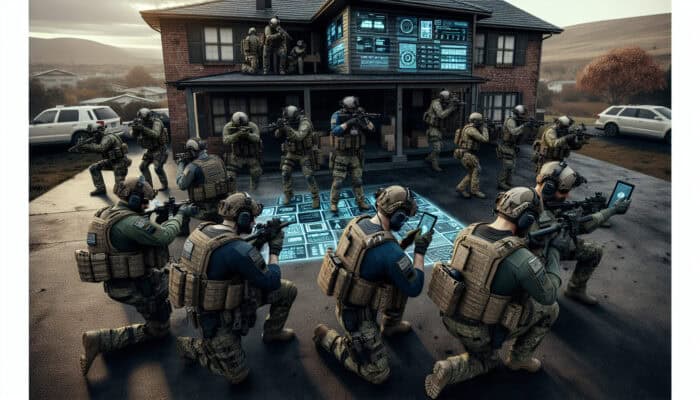Enhance Your House Clearance Efficiency Through Expert Multi-Team Coordination
What Constitutes Multi-Team Coordination in House Clearance Operations?

Multi-team coordination in the context of house clearance embodies a structured and collaborative approach among various groups working cohesively towards a singular goal, particularly in executing house clearance tasks. This methodology demands a strong emphasis on effective communication, meticulous planning, and a transparent distribution of responsibilities among team members to significantly enhance operational efficiency. The key components that contribute to triumphant multi-team coordination include:
- Clearly defined roles and responsibilities for each team member
- Effective communication strategies tailored specifically for team interactions
- Regular training and safety drills to ensure preparedness and responsiveness
- Utilisation of technology for instantaneous updates and coordination
- Regular feedback and improvement sessions to refine operational processes
- Conflict resolution strategies to maintain team harmony
- Comprehensive planning and execution to streamline all operations
- Adherence to safety protocols and compliance with regulations
By effectively implementing these elements, teams can operate cohesively, reducing interruptions and maximising productivity throughout the house clearance process.
Why is Coordination Vital for Successful House Clearance Operations?
Effective coordination in house clearance plays an integral role as it ensures that tasks are executed in a timely and safe manner. When teams function synchronously, the likelihood of delays and safety hazards diminishes significantly. Proper coordination encourages a seamless integration of various teams, empowering them to address challenges swiftly and efficiently, which is imperative for achieving successful clearance outcomes.
What Legal Considerations Must Be Acknowledged in House Clearance within the UK?
House clearance operations in the UK are governed by an array of legal stipulations, including waste disposal laws and health and safety regulations. A thorough understanding of these laws is essential for conducting successful operations, as it aids in minimising legal liabilities and enhances the integrity of the operation. Compliance not only safeguards the teams involved but also bolsters trust with clients and stakeholders alike.
Insights from Experts on Enhancing Multi-Team Coordination for House Clearance

How Can Teams Be Organised Effectively for House Clearance Projects?
The effective structuring of teams is critical to boosting productivity in house clearance initiatives. A well-defined hierarchy can streamline operations; for instance, a lead coordinator supervises the entire project, a safety officer guarantees compliance with health regulations, and a logistics manager oversees the transportation of items. In a recent large-scale clearance operation in London, the clear delineation of responsibilities allowed teams to work autonomously while remaining aligned with the overarching mission. Moreover, incorporating cross-functional teams enables individuals with diverse expertise to collaborate towards common objectives, maximising the use of varied skills.
Having a structured team not only enhances efficiency but also fosters a culture of accountability among team members. Each individual understands their specific duties, resulting in a more organised and unified effort. Furthermore, conducting regular evaluations of team dynamics and roles can lead to ongoing performance improvements over time.
What Are the Best Communication Tools for House Clearance Teams?
Effective communication stands as a cornerstone of successful multi-team coordination in house clearance operations. Employing tools such as walkie-talkies and mobile applications, alongside regular team briefings, can significantly boost the flow of information. For example, utilising dedicated mobile apps designed for project management allows teams to share updates in real-time, monitor their progress, and address issues as they arise.
To implement these communication tools effectively, it is advantageous to conduct an initial survey among team members to ascertain their preferred communication methods. Subsequently, training sessions can be organised to ensure that everyone is proficient in using the selected tools. Regularly scheduled briefings, combined with a digital communication platform, will guarantee that all team members are informed and can adapt to any changes that may occur.
How Can Conflicts Within House Clearance Teams Be Managed Effectively?

Conflicts can naturally arise within teams due to differing opinions, work styles, or misunderstandings. Implementing effective strategies for conflict resolution is essential for maintaining team cohesion and productivity. Establishing an open dialogue where team members feel valued can significantly alleviate tensions. Encouraging feedback and conducting regular check-ins can help identify potential sources of conflict early. When issues arise, addressing them promptly through mediated discussions that prioritise collaborative solutions ensures that every voice is heard and respected.
How Can Safety Be Ensured Across Multiple Teams During Clearance Operations?
Implementing comprehensive safety protocols is paramount in multi-team house clearance efforts. Regular safety drills, clear communication of potential hazards, and appointing dedicated safety officers for each team can significantly reduce the risk of accidents. For example, during a recent clearance project in Manchester, teams participated in weekly safety drills, which not only boosted morale but also resulted in zero incidents throughout the operation.
Additional safety measures to consider include providing personal protective equipment (PPE), establishing clear evacuation routes, and maintaining an effective emergency response plan. Continuous monitoring and evaluation of safety protocols, along with open communication regarding safety concerns, can foster a culture of awareness and safety among all team members.
Key Steps to Achieve Successful Multi-Team House Clearance Operations
What Are the Fundamental Initial Planning Stages for House Clearance?
The initial planning stages of house clearance form the foundation for successful operations. This phase involves a comprehensive assessment of the property, identifying potential hazards, and determining the required resources for the task. Engaging with property owners and stakeholders to understand their expectations and requirements is also crucial.
A detailed plan should cover logistics, including timelines, workforce distribution, equipment needs, and waste disposal arrangements. By dedicating time to thorough planning, teams can avoid common pitfalls, ensuring a smoother execution phase. Additionally, creating a contingency plan for unexpected challenges can enhance resilience, paving the way for successful outcomes.
How to Implement House Clearance Effectively?
The execution phase is where theoretical planning transitions into actionable performance. Teams must collaborate seamlessly to remove items, clean the property, and prepare it for its subsequent use. Coordination during this phase is vital; teams must communicate effectively to minimise disruptions and ensure safety throughout the operation.
Regular team briefings during execution help keep everyone updated about progress and any emerging issues. Utilising project management software can streamline monitoring of progress and facilitate swift adjustments to plans as necessary. The ability to modify workflows promptly significantly enhances efficiency and reduces the risk of delays.
What Are the Crucial Post-Clearance Procedures to Follow?
Upon completing the clearance process, several critical post-clearance procedures must be adhered to in order to ensure the property remains secure and compliant with all legal requirements. Teams should confirm that waste is disposed of correctly and that all documentation related to the clearance is completed and filed appropriately.
A thorough walkthrough of the property is essential to ensure no items are left behind and that all safety standards have been met. Engaging with property owners to review the work completed and gather feedback is also a valuable practice that can enhance future operations and build trust with clients.
What Are the Significant Benefits of Multi-Team Coordination for House Clearance?
How Does Multi-Team Coordination Enhance Operational Efficiency?
A primary advantage of multi-team coordination is the substantial boost in efficiency it delivers. By distributing the workload among various teams, each concentrating on specific tasks, clearance times can be significantly reduced. For instance, while one team focuses on heavy lifting, another manages logistics, leading to a streamlined process that accelerates overall completion time.
This division of labour not only expedites the operation but also cultivates a more organised approach. Teams can work on parallel tasks without impeding each other, ultimately enhancing productivity and alleviating stress often associated with large-scale clearances.
What Enhanced Safety Measures Are Associated with Multi-Team Coordination?
In a multi-team environment, the implementation of safety protocols can be both thorough and effective. With designated safety officers for each team, there is an increased focus on adherence to health and safety regulations. Regular safety briefings and drills promote a culture of preparedness, ensuring that all team members are aware of potential risks and strategies to mitigate them.
Moreover, the presence of multiple teams allows for constant oversight and monitoring of safety practices. This vigilant supervision can significantly reduce the incidence of accidents, fostering a safer working environment for everyone involved in the house clearance.
How Does Coordination Improve Resource Management?
Effective coordination among multiple teams enhances resource management, resulting in cost savings and a more efficient use of assets. By assessing resource needs in advance and allocating workforce, equipment, and time accordingly, operations can proceed smoothly without unnecessary delays or wastage of resources.
For example, during a house clearance project in Birmingham, effective coordination enabled shared equipment utilisation among teams, streamlining costs and optimising efficiency. This strategic approach to resource management ensures that each team possesses the necessary tools to perform effectively while minimising unnecessary expenditure.
Proven Approaches for Effective Multi-Team Coordination in House Clearance
How to Train Teams for Optimal Coordination in House Clearance?
Training plays a crucial role in fostering effective coordination among teams engaged in house clearance. The training programme should cover essential areas, including communication protocols, safety guidelines, and the specific tasks each team will undertake. Regular drills and workshops can enhance team preparedness and ensure that members are well-acquainted with their roles.
Moreover, expert analysis indicates that scenario-based training, where teams rehearse responses to potential challenges, can significantly improve their ability to collaborate effectively under pressure. Ongoing training sessions can also provide a platform for teams to reflect on past experiences, share insights, and refine their strategies for future operations.
What Role Does Technology Play in Enhancing Coordination?
Integrating technology into multi-team coordination can greatly streamline operations. Project management software and tracking systems enable teams to monitor progress and make real-time modifications to plans as necessary. For instance, employing a cloud-based platform allows all team members to access updated information instantly, ensuring everyone remains aligned.
Furthermore, leveraging technology for managing schedules and logistics can reduce the risk of miscommunication and errors. By utilising digital tools, teams can enhance their efficiency, resulting in quicker and more effective house clearance operations.
How Does Continuous Improvement Contribute to Team Performance?
Establishing a culture of continuous improvement is essential for bolstering multi-team coordination. Regular reviews and feedback sessions provide teams with the opportunity to assess their performance, identify areas for enhancement, and implement changes based on lessons learned from previous projects.
This cycle of feedback and improvement not only boosts team morale but also leads to enhanced operational efficiency over time. Engaging team members in this process encourages ownership of their roles and nurtures a proactive approach to problem-solving.
Why is It Crucial to Define Clear Roles and Responsibilities?
Clearly defining roles and responsibilities within each team is vital for preventing confusion and overlap. Every team member must comprehend their tasks and how they contribute to the overall clearance process. This clarity fosters accountability and empowers team members to execute their duties effectively.
To establish clear roles, a comprehensive project plan should be developed that outlines each team member's responsibilities, ensuring that everyone is aware of their expected tasks. Regular check-ins can help reinforce these roles and provide opportunities for team members to discuss their experiences and challenges, cultivating a sense of shared understanding and collaboration.
What Are the Best Practices for Maintaining Effective Communication Channels?
Utilising effective communication channels is crucial for sustaining coordination among multiple teams. Tools such as radios, mobile applications, and regular briefings ensure that all teams remain aligned and can respond promptly to any changes or issues arising during the clearance operation.
Establishing a standard communication protocol will streamline information sharing and minimise the risk of miscommunication. Regular updates and briefings keep everyone informed of progress and emerging challenges, fostering a collaborative environment where all team members feel included and engaged in the process.
Successful Case Studies Highlighting Multi-Team House Clearance in the UK
Insights Gathered from Large-Scale Clearance Projects
Analysing large-scale house clearance projects provides invaluable insights into how multi-team coordination can effectively manage complex clearance tasks. For instance, a significant project in East London involved the clearance of a vast estate, necessitating collaboration among multiple teams. This case highlighted best practices, such as regular coordination meetings, shared technology platforms, and meticulous planning, which contributed to the project's success.
Furthermore, this case study underscored the importance of adaptability, as teams were able to respond to unexpected challenges by reallocating resources and adjusting timelines, ultimately completing the project ahead of schedule. Investigating such successful projects offers a roadmap for refining future multi-team operations.
What Challenges Do Urban and Rural Clearances Present?
Different environments introduce unique challenges for house clearance operations. Urban settings often present logistical hurdles, such as restricted access for large vehicles and the necessity for permits, while rural areas may face accessibility issues due to their remote locations. For example, a rural clearance project in the Cotswolds required meticulous planning to ensure that all necessary equipment could be transported to the site without complications.
Understanding these environmental challenges is crucial for teams to devise appropriate strategies. Urban clearances often benefit from improved communication with local authorities, while rural clearances may necessitate a focus on transportation logistics and alternative access routes to ensure operational success.
What Valuable Lessons Can Be Learned from Previous Projects?
Past house clearance projects provide critical lessons that can refine strategies for future multi-team operations. Evaluating what worked effectively and what encountered challenges offers insights into enhancing coordination efforts. For instance, a case study from a clearance operation in Manchester revealed that early engagement with stakeholders significantly improved timelines and increased stakeholder satisfaction.
Moreover, documenting lessons learned creates a reference repository that teams can consult for future projects. Embracing this continuous learning mindset enables teams to adapt their strategies based on previous experiences, ultimately enhancing overall success rates and operational efficiency.
Frequently Asked Questions Concerning Multi-Team Coordination
What is the role of a lead coordinator in multi-team house clearance?
The lead coordinator is responsible for overseeing the entire house clearance operation, ensuring that all teams align with project goals, managing resources, and facilitating communication among teams for seamless execution.
How can technology improve house clearance operations?
Technology enhances house clearance operations by streamlining communication, tracking progress in real-time, and effectively managing schedules, leading to heightened efficiency and reduced errors.
What safety protocols should be implemented during house clearance?
Safety protocols may include mandatory use of PPE, regular safety drills, effective hazard communication, and appointing dedicated safety officers for each team to ensure compliance and minimise risks.
How do you handle conflicts between team members?
Conflicts can be managed through open dialogue, mediation, and fostering a culture where team members feel secure expressing their concerns, enabling constructive resolution to disputes.
What are the legal requirements for house clearance in the UK?
House clearance in the UK must comply with waste disposal laws, health and safety regulations, and local council guidelines to ensure legal compliance throughout the process.
How can regular feedback enhance team performance?
Regular feedback sessions cultivate a culture of continuous improvement, allowing teams to assess their performance, identify areas for enhancement, and implement changes for future operations.
What are the advantages of having a dedicated safety officer for each team?
A dedicated safety officer ensures that safety protocols are consistently upheld, provides immediate guidance on safety issues, and enhances overall awareness of workplace hazards.
How important is initial planning in house clearance operations?
Initial planning is crucial for a successful house clearance, as it lays the groundwork for operations, helping teams identify necessary resources, hazards, and timelines essential for effective execution.
What challenges do urban house clearance operations face compared to rural ones?
Urban house clearance often encounters logistical challenges such as limited access and regulatory requirements, while rural clearance may deal with accessibility issues due to remote locations.
How does multi-team coordination impact operational efficiency?
Multi-team coordination enhances operational efficiency by enabling the division of labour, allowing teams to focus on specific tasks simultaneously, which accelerates the overall clearance process.
Connect with us on Facebook!
The Article: Multi-Team Coordination for House Clearance: UK Strategies Was First Found At https://birminghamhouseclearance.com
The Article House Clearance Strategies: Multi-Team Coordination in the UK Was Found On https://limitsofstrategy.com

